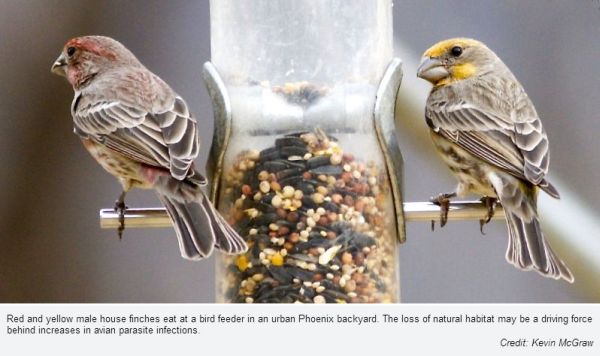In the depths of a bitter winter it’s a challenge to wade through ice and snow to refill the feeders and even more challenging to pull in those feeders and clean them. Every day I put it off. This message is for all of us who’ve been procrastinating.
A new study published this week in PLOS One has found a direct link between urbanization and avian infections. The denser the human population, the sicker the birds.
Mathieu Giraudeau, Melanie Mousel, Stevan Earl, and Kevin McGraw studied canarypox and Coccidian infections in male house finches (Haemorhous mexicanus) in the Phoenix, Arizona metro area. Like chicken pox, canarypox forms blisters on the skin. Coccidiosis is caused by parasites in the intestinal tract, spread by infected feces or ingestion of infected tissue. During the study, house finches with coccidiosis were found to be fatter but unable to absorb the nutrients they ate.
At each site where they trapped and diagnosed house finches, the researchers also noted the land use patterns and habitat. Then they looked for correlations and found: The denser the human population and the less natural the habitat, the higher the number and intensity of infections in the birds.
Why?
According to Science Daily: “Much like the spread of human disease in populated areas, urban centers can foster increases in multiple disease types in wild animals,” said Kevin McGraw, senior author of the study. “We are now investigating the mechanism underlying this observation.”
And from the PLOS One article: “Humans may facilitate infections in these birds via bird feeders (i.e. horizontal disease transmission due to unsanitary surfaces and/or elevations in host population densities) and/or via elevations in other forms of physiological stress (e.g. corticosterone, nutritional).”
Interestingly this photo from the study may hold a visual clue to the health of these two birds. Male house finches should have red faces like the bird on the left. Those with yellow have not absorbed enough carotene to produce red feathers. Perhaps the yellow-faced bird has coccidiosis.
Bottom line: Clean your bird feeders.
Read more here in Science Daily or the research article in PLOS One.
p.s. Click here for information on how to clean your bird feeders.
(photo by Kevin McGraw, Arizona State University)
